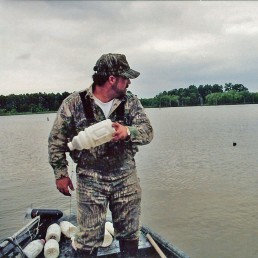Jug Fishing in Summer
SHARE THIS POST
“Jugging” requires reading structure, current and forage conditions. The Midwest has an abundance of habitats fished by juggers during hot, summer evenings.
A jugging rig is composed of an airtight plastic jug or bottle tethered with three to six feet of monofilament line and a 5/0 hook or 3/0 treble hook. Forty- or 50-pound mono or braided line is best.
Two-liter soft drink bottles make good jugs. Any plastic bottle will work.
Anglers wrap the nylon cord around the bottle for storing or transport. They neatly tuck the single hook into the plastic base cup.
A variation of jug fishing involves cutting a pool noodle into 10-inch sections and using it instead of a bottle. Wind the line around the noodle when stored.
Before taking to the water, check local site regulations to make sure not to violate any laws. Many Midsouth lakes with catfish allow jug fishing, but some have site-specific conditions. Northern waters often have more stringent regulations regarding the use of jugs for fishing.
When fishing a reservoir or lake, get a map showing the bottom contours. Begin by placing jugs about 100 yards upwind of the target structure and about 10 feet apart. This broad coverage increases the odds of finding fish.
A clear-water, night fishing situation is probably most productive. During the daytime, the hook should be about two or three feet off the bottom. At night, in summer, suspend the hooks about two feet below the surface. Use the shallower pattern during the daylight hours on shallow lakes with river channels winding through them.
Are you enjoying this post?
You can be among the first to get the latest info on where to go, what to use and how to use it!
Use of jugs is possible either day or night with some degree of success. Many anglers put out jugs at dusk and return to collect them in the morning. Such a pattern works better on small bodies of water since hooked catfish sometimes travel long distances with the jug.
For very deep areas, try a deep-water rig. This rig consists of Number 18 braided nylon line in brown or green. At the end of the nylon line, attach a brass swivel. Then 6 feet of 50-pound monofilament line. Finish the rig with a 2/0 hook and 1/4-ounce bell sinker a foot above the hook. Then adjust line length to keep the bait a foot or so off the bottom.
On large rivers, structure tends to be more obvious. Sandbars, wing dams, bends, and drift piles of wood all produce fish. Permit the jugs to drift downstream toward the structure with you drifting along behind them.
Baits for jug fishing tend to be worm, minnows, cut bait or catalpa worms. No single type of bait seems to outclass others.
Once baited up and released, watch your jugs like an unruly flock of sheep. On rivers, jugs seem to like to run behind wingdams and hide or separate from each other.
Some anglers paint their jugs orange for visibility. It is fun to watch 3 or 4 jugs dancing at once with fish on the hook. A long, sturdy pole with a strong hook on the end helps to release an entangled jug or capture one rapidly leaving behind a fish.
If you want to try a different, exciting fish species or technique, you’ll find plenty of suggestions in every issue of MidWest Outdoors. Subscribe on our website.
MWO
SHARE THIS POST
You may also like...
Nothing found.
Did you enjoy this post?
You can be among the first to get the latest info on where to go, what to use and how to use it!
Don Gasaway
Don Gasaway is a veteran freelance outdoor writer from Marion, Ill. He may also be found at: https://www.facebook.com/DonGasawayWriter and facebook.com/Wandering Angler. Comments are welcome
